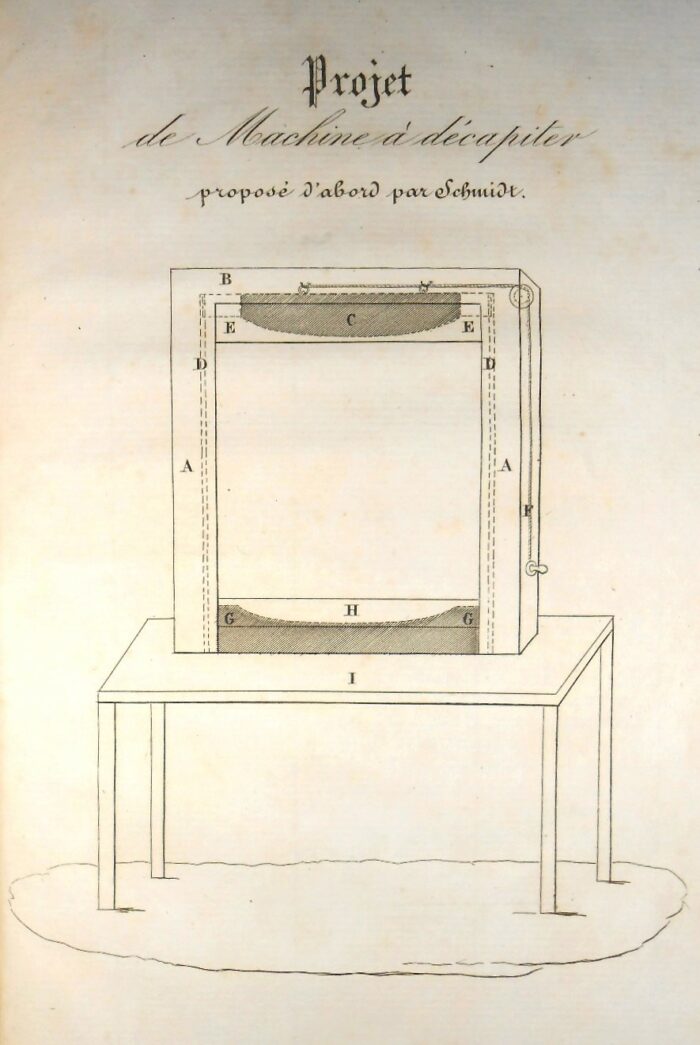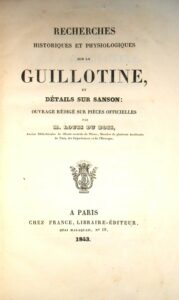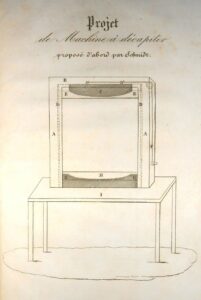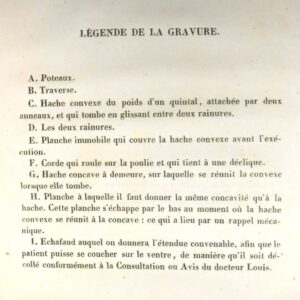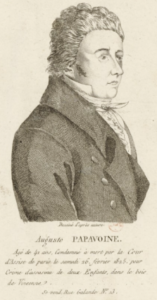Louis-François Du Bois. Recherches historiques et physiologiques sur la guillotine, et détails sur Sanson : ouvrage rédigé sur pièces officielles. Paris, France, 1843. In-8°. 35, [1] pages, one plate in fine. Contemporary pink half-percaline, long gilt title on spine.
First edition, complete with lithographed plate showing the “Projet de machine à décapiter proposé d’abord par Schmidt” [Project for a beheading machine first proposed by Schmidt].
The history of the guillotine (its Scottish, German and Italian origins with the famous Mannaia, its development and adoption, with details of its cost, by the Convention in 1792, the first executions, defects and improvements), medical debates on momentary survival after decollation, and therefore on the suffering or otherwise of the guillotined; this is followed by a chapter devoted to the executioners and the Sanson family, a famous dynasty of executioners from the seventeenth to the nineteenth century. Finally, three supporting documents conclude this interesting booklet: the “avis motivé sur le mode de décollation” [reasoned opinion on the method of decollation] by Doctor Antoine Louis (who gave the guillotine its nickname of Louison or Louisette), the “Mémoire d’observations sur l’exécution de la tête tranchée [par l’épée], avec la nature des différens inconvéniens qu’elle présente, et dont elle sera vraiment susceptible” [Memorandum of observations on the execution of the severed head [by the sword], with the nature of the various inconveniences it presents, and of which it will really be susceptible] by the executor Sanson, and the song “Sur l’inimitable Machine du médecin Guillotin propre à coupes les têtes et dite de son nom Guillotine” [On Doctor Guillotin’s inimitable machine for cutting off heads, known by its name Guillotine] published in Les Actes des Apôtres in December 1789 (“Guillotin, / Médecin / Politique, Imagine un beau matin / Que pendre est inhumain / Et peu patriotique. / Aussitôt / II lui faut / Un supplice / Qui, sans corde ni poteau, / Supprime du bourreau / L’office. […]”) [Guillotin, / Doctor / Politician, imagines one fine morning / That hanging is inhuman / And unpatriotic / He immediately needs / A punishment / Which, without rope or post, / Eliminates the executioner’s / Office]
The author, Louis-François Du Bois (Lisieux, 1773 – Mesnil-Durand, 1855), was a historian, poet, translator, scholar, agronomist, politician and administrator. A friend of Rouget de Lisle, he suggested the correction of two verses of the Marseillaise, and wrote an additional verse, known as the ‘children’s verse’. He was librarian at the École Centrale de l’Orne and a member of several academies.
The decapitation machine made by Schmidt, a Strasbourg manufacturer of harpsichords and pianos, was tested on three corpses at Bicêtre under Sanson’s watchful eye and was adopted.
At the end, there is a press clipping from the Courrier français, dated 25 August 1846, containing a feuilleton by Gustave Brunet entitled “Une exécution capitale, récit trouvé dans les papiers d’un Anglais” [A capital execution, an account found in the papers of an Englishman], recounting the execution in the Place de Grève in March of Louis-Auguste Papavoine, who slit the throats of two children and their mother in the Bois de Vincennes.
The author describes the crowd, the condemned man’s attitude, the execution process, the executioner’s efficiency, the physical reactions of the body of the condemned man after decollation and the autopsy of his skull at the Ecole-de-Médecine. ‘I wanted […] to teach how it is done and how one dies on it’.
Spine sunned.
Rare copy.
1 000 €
